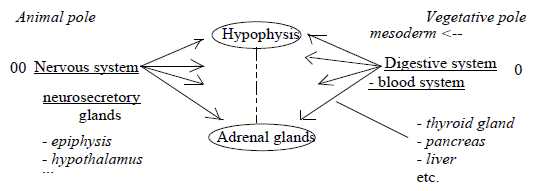|
1.
Glands - a general structure: The
System
level - like an underlying
"syntax" - becomes formulated
in differentiation of glands on
all following organ, tissue and
cell levels.
Glands
are formed from all kinds of epithelium.
Glands means actually differentiation
as such between substances produced
by epithelial cells. The
basic model for glands seems given
already on the gastrula stage of
embryo development: an already specialized
surface layer of cells, which faces
on to outer room and an inner cavity
and invaginates from the surface
in certain areas in similarity with
how gland tissue is descended epithelium.
The whole
archenteron could in this sense
be regarded as a primary gland,
as well as the neural tube with
its secretion of cerebrospinal fluid
(CSF).
2. Two special
glands:
The nervous system
and nutrition system as two opposite
directed vector fields meet during
the evolution in two glands on the
organ level: in hypophysis
and adrenal glands
composed of tissue from both. They
become complex combinations of those
poles (or partial structures) from
underlying level of higher dimension
degree (d-degree) on a level of
lower d-degree.
(Systems
→>
Organs as a d-degree step 4 →>3
in the level
chain in our interpretations
here.)
The
information via hormones is chemical
as are the transmitters in the very
synapses of the nervous system.
The way of information goes the
way of the nutrition system via
the blood system outwards.
 Fig
Gl-1-37-1 In this meeting
of poles in hypophysis and adrenal
glands there is also a geometrical
"pole exchange" in terms
of the dimension model:
Nervous
tissue (00-pole in relation to nutrition
system from 0-pole) becomes the
inner, the center, the marrow of
adrenal glands from cells in the
sympathetic nervous system, and
the tissue from the nutrition system
(coelom, indirectly from vegetative
pole) becomes anticenter, the adrenal
cortex.
 Fig
Gl-2-37-2 Fig
Gl-2-37-2 In
hypophysis it's tissue that has
immigrated from the throat (pharynx)
that forms a pocket around the nervous
tissue.
(It's
certainly said that the pocket derives
from ectoderm, not the vegetative
pole in the embryonic development.
Yet, throat is part of the digestive
canal in the nutrition system.)
The hypophysis is historically
a later development in evolution
and it may be asked which more such
combined organs that could follow
with a further biological development?
Is there actually any other reason
than a dimensionally given "pole
meeting" that biologically
- chemically gives cause for adrenaline
cortex and adrenaline marrow (medulla)
to combine to one organ, when they
produce different types of substances
(cortex: steroids as cortisol; marrow:
adrenaline and noradrenaline)? Pancreas
with its mixed gland tissues seems
to represent a secondary type of
"pole meeting" within
the nutrition system, In humans
it develops as a compound of one
ventral and one distal "bud"
or invagination from the intestine,
hence from a polarity of second
order. It is also two-way directed
in its function with both endocrine
and exocrine secretion.
3. Gland shapes:
As glands are epithelium invaginating
inwards, the macrostructure of glands
seems dimensionally develop inwards
also in the sense of towards higher
d-degrees in shape: from single
cells to "linear" tube
forms to branched, hollow tubes
along 2-3 coordinate axes - to branched,
cell-filled tubes - to centered,
cell-filled organs with only canals
connecting to the surface of epithelium.
These latter develop often radially
ordered cell lines as of pole 3b
in our model and get own blood supply.
Hence, it's
a development as in d-degree steps
0 →>
1 →>2
→>
3. The liver for instance has first
only a tube form.

Fig
Gl-3-38
(Cf.
figure b with how coelom first grow
out from archenteron in the embryo.) Surface
epithelium is often of squamus
type (low, flat), while epithelium
of glands often is cubic (cuboidal):
Such a detail points to a d-degree
step of type 3←2 already on the level
of single cells. (Stratified epithelium
may have up to 6 layers. Cf. 6 layers
in the cerebral cortex.)
4. Differentiation of glands:
We could see the differentiation
in terms of polarities related to
the dimension model: in directions,
in center - anticenter formation
(as mass - space) and in positions
along coordinate axes - naturally
besides type of secreted substances:
On the level of
the whole organism there is the
polarity between glands with secretion
outwards the surroundings and those
with secretion inwards: skin glands
versus internal ones.
On
the organ and tissue levels there
is the polarity exocrine - endocrine
glands, directions of secretion
(poles 4b - 4a).
The
general development seems to go
from exocrine secretion outward
cavities to more endocrine secretion,
inward blood vessels.
In centered
organs the polarity center - anticenter
as marrow - cortex appears as the
d-degree relation 3 - 2.
The
differentiation along the Front
- Back axis of the digestive canal
in relative positions is reasonably
to a certain degree related to kind
of passing substances, carbohydrates,
proteins, fatty acids, but that's
surely only a part of the truth,
underlying polarities of the coordinate
axes another.
A
sketch:
 Fig
Gl-4-33-3 Fig
Gl-4-33-3 Generalized
it seems possible to regard the
whole body more or less as a hierarchy
of glands. Simultaneously the development
of glands implies a continuous growth
of inner surfaces from the first
embryological stages (like the growth
of a coastline towards infinity
when one goes deeper and deeper
into details). A question is if
position on a surface is a necessary
condition for the differentiation
of cells in genetic activity - or
the reverse, a result of it?
To 05. Blood system
|

 Fig
Gl-2-37-2
Fig
Gl-2-37-2 
 Fig
Gl-4-33-3
Fig
Gl-4-33-3